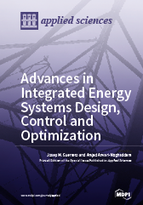Advances in Integrated Energy Systems Design, Control and Optimization
A special issue of Applied Sciences (ISSN 2076-3417). This special issue belongs to the section "Energy Science and Technology".
Deadline for manuscript submissions: closed (30 April 2017) | Viewed by 74206
Special Issue Editors
Interests: microgrids; renewable energy systems; neuroscience-based artificial intelligence; digital twins; cybersecurity
Special Issues, Collections and Topics in MDPI journals
Interests: power system operation and planning; microgrids and active energy networks; energy markets and analytics; operations research and its applications to energy systems
Special Issues, Collections and Topics in MDPI journals
Special Issue Information
Dear Colleagues,
In the face of climate change and resource scarcity, energy supply systems are on the verge of a major transformation, which mainly includes the introduction of new components and their integration into the existing infrastructures, new network configurations and reliable topologies, optimal design and novel operation schemes, and new incentives and business models. This revolution is affecting the current paradigm and demanding that energy systems be integrated into multi-carrier energy hubs. It is greatly increasing the interactions between today’s energy systems at various scales (ranging from the multinational, national, community scales down to the building level) and future intelligent energy systems, which are able to incorporate an increasing amount of often fluctuating, renewable energy sources (RESs). It is also increases the need for the integration of energy storage options into the energy mix, not only to reduce the need for increased peak generation capacity, but also to enhance grid reliability and support higher penetration of RESs. Moreover, this transformation is accommodating active participation of end-users as responsive prosumers at different scales, which in turn help to reduce energy costs to all consumers, increase reliability of service and mitigate carbon footprints. However, this plan of action necessitates regulatory frameworks, strategic incentives and business models for efficient deployment. This Special Issue will cover these promising and dynamic areas of research and development, and will allow gathering of contributions in design, control and optimization of integrated energy systems. This Special Issue also seeks papers to report advances in any aspect of these developments. The manuscripts should be unpublished and report significant advancement.
Prof. Dr. Josep M. Guerrero,
Dr. Amjad Anvari-Moghaddam
Guest Editors
Manuscript Submission Information
Manuscripts should be submitted online at www.mdpi.com by registering and logging in to this website. Once you are registered, click here to go to the submission form. Manuscripts can be submitted until the deadline. All submissions that pass pre-check are peer-reviewed. Accepted papers will be published continuously in the journal (as soon as accepted) and will be listed together on the special issue website. Research articles, review articles as well as short communications are invited. For planned papers, a title and short abstract (about 100 words) can be sent to the Editorial Office for announcement on this website.
Submitted manuscripts should not have been published previously, nor be under consideration for publication elsewhere (except conference proceedings papers). All manuscripts are thoroughly refereed through a single-blind peer-review process. A guide for authors and other relevant information for submission of manuscripts is available on the Instructions for Authors page. Applied Sciences is an international peer-reviewed open access semimonthly journal published by MDPI.
Please visit the Instructions for Authors page before submitting a manuscript. The Article Processing Charge (APC) for publication in this open access journal is 2400 CHF (Swiss Francs). Submitted papers should be well formatted and use good English. Authors may use MDPI's English editing service prior to publication or during author revisions.
Keywords
- Integrated Energy systems designs, monitoring and supervisory control
- Multi-carrier energy hubs
- Energy internet
- Hierarchical control applications
- Optimization Techniques
- Risk modeling and management
- Energy efficiency and sustainable development
- Business models, markets and regulatory frameworks







